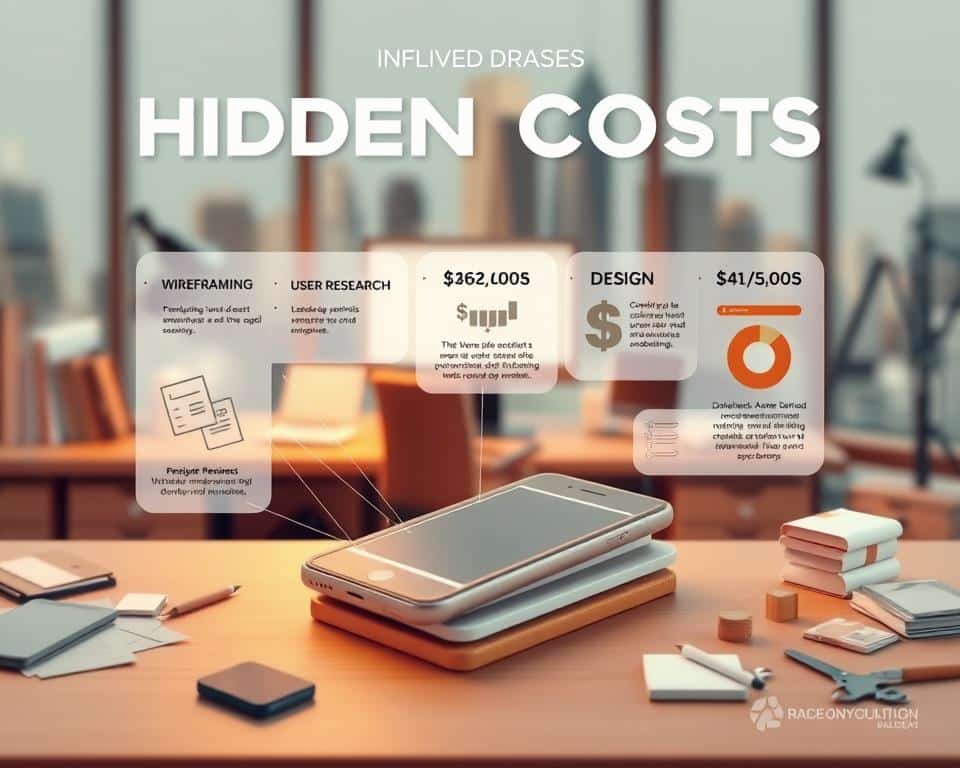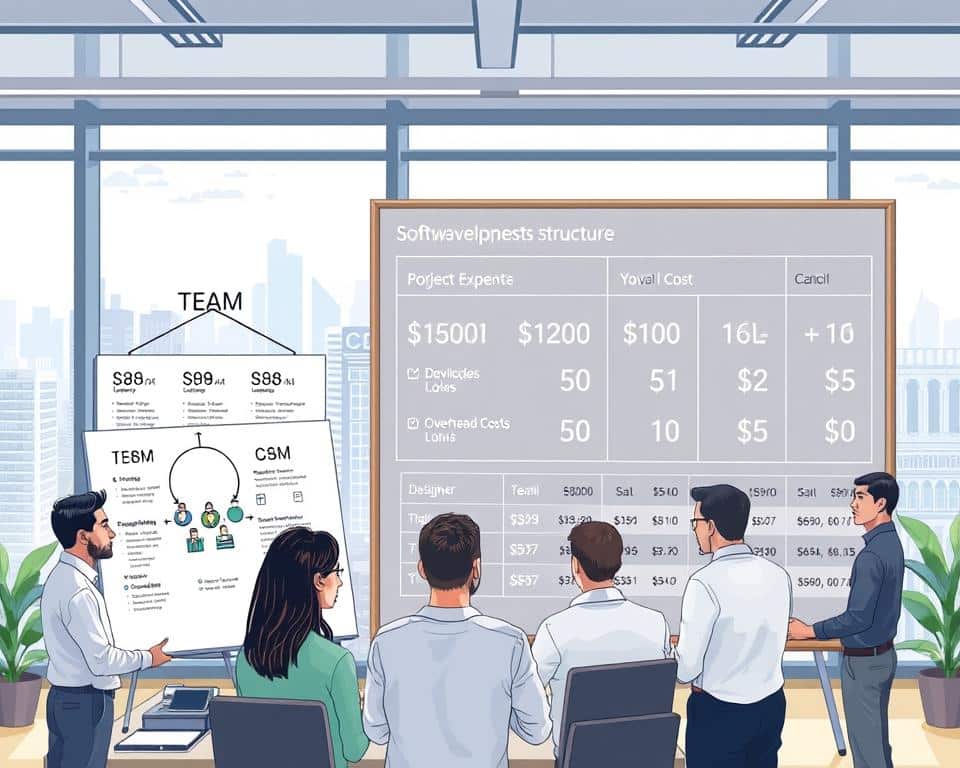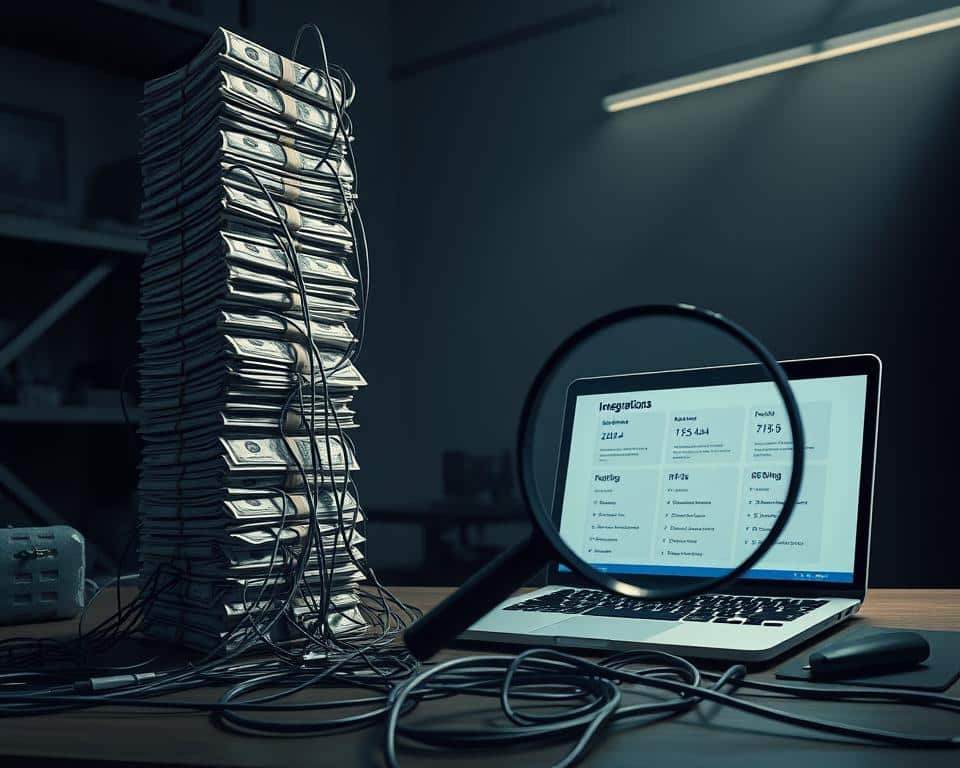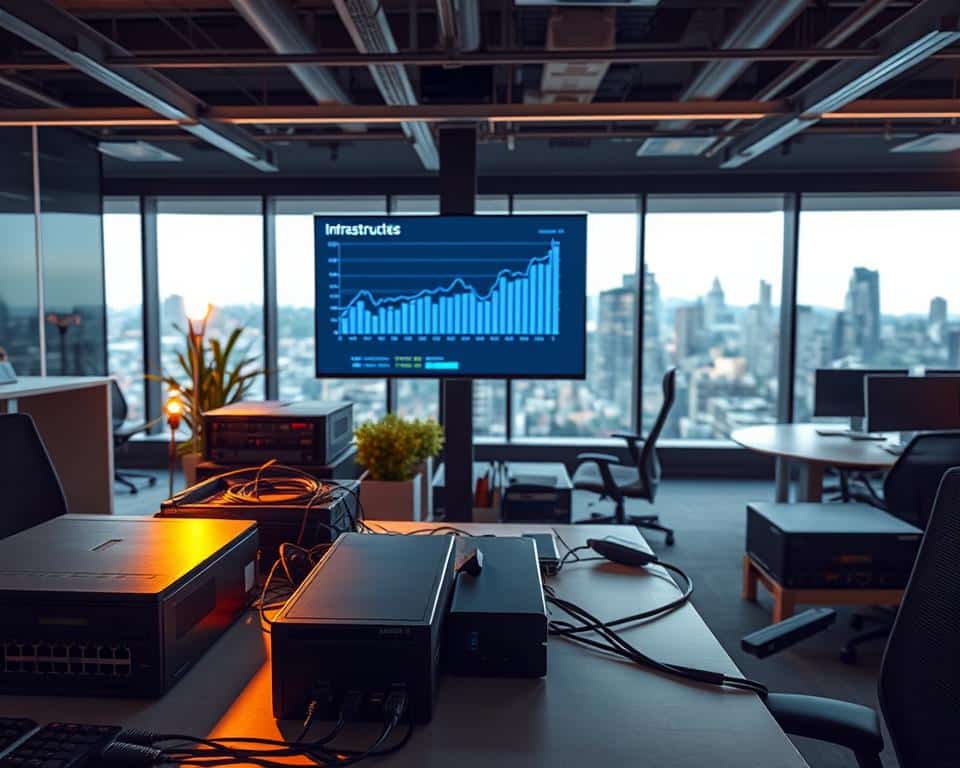Creating an app is a complex and expensive task. Many businesses know the upfront costs for app development costs. But they often miss the hidden expenses that pop up during the project.
It’s key to understand these hidden expenses for good budgeting for app development. Without knowing these costs, businesses might face budget problems. This could harm the success of their app project.
Table of Contents
Key Takeaways
- Knowing all the costs of app development is vital for success.
- Hidden expenses can greatly affect the budget.
- Good budgeting for app development means thinking about all costs.
- Businesses need to watch out for budget overruns.
- Successful app development needs careful financial planning.
The Reality of App Development Budgeting
The truth about app development budgeting is much more complex than first thought. Many people, both developers and clients, don’t fully understand the costs. This leads to spending more than planned and delays in finishing the project.

Why Initial Estimates Often Fall Short
First guesses for app development costs are often too low. This is because projects can be very complex, with unexpected technical issues and changes in what’s needed. For example, a project might need extra features or connections that weren’t thought of at first. This can make the cost go up.
Studies show that about 60% of projects end up costing more than expected because of bad first guesses. It’s key to work with skilled developers who can give a better idea of what the project will really need. For tips on saving money, check out this resource.
The 20-30% Buffer Rule for Realistic Planning
To avoid going over budget, using the 20-30% buffer rule is helpful. This means adding 20-30% to the first cost estimate to cover extra expenses. This buffer helps manage surprises and keeps the project financially stable.
By adding this buffer, developers and clients can plan for unexpected costs. This makes it less likely for the budget to be exceeded.
Pre-Development Hidden Costs
Before starting app development, it’s key to know the pre-development costs. These costs can greatly affect your budget. The pre-development phase is crucial for a successful project, with several steps that cost money.
Market Research Expenses
Doing thorough market research is vital. It helps you understand your audience, their needs, and likes. This process involves gathering and analyzing data, which can be expensive.
Market research expenses include survey tools, focus group organization, and data analysis software. For example, using SurveyMonkey or hiring a market research firm can cost from a few hundred to several thousand dollars.
Competitor Analysis Tools and Subscriptions
It’s important to analyze your competitors to stand out and find market gaps. Competitor analysis tools and subscriptions give insights into competitors’ strengths and weaknesses. Tools like App Annie or Sensor Tower are valuable but have subscription fees from $100 to over $1,000 per month.
Legal Consultations and Documentation
Legal consultations are key to ensure your app follows laws and regulations. This includes making Terms of Service and Privacy Policy documents. Legal fees vary based on document complexity and lawyer rates.
It’s also important to think about Intellectual Property (IP) considerations. This includes trademark registration and patent applications to protect your app’s unique features and branding.
Terms of Service and Privacy Policy Creation
Creating detailed Terms of Service and Privacy Policy documents is essential. They outline how user data is handled and app usage terms. The cost of these documents varies but is crucial for your app’s legal standing.
Intellectual Property Considerations
Protecting your app’s IP is crucial in a competitive market. This includes trademark and patent registration and ensuring your development doesn’t infringe on existing IPs. IP protection costs can be high, including legal fees for registration and potential lawsuits.

In conclusion, pre-development costs are a big part of app development. Understanding and budgeting for market research, competitor analysis, and legal consultations helps developers prepare for challenges ahead.
Design Phase Surprises
The design phase can bring surprises that affect the budget. This is where the app’s look and feel are created. But, unexpected costs can pop up, changing the budget.
UI/UX Iterations and Their Cost Impact
UI/UX iterations are key to making the app easy to use and nice to look at. But, doing many of these can cost more. Each one takes more time and money, adding up fast. It’s important to find a balance between quality and budget.
Custom Graphics and Animation Expenses
Custom graphics and animations make the app better. But, making them can be expensive. The cost depends on how detailed they are. Developers should think about whether custom graphics are worth it or if pre-made ones are better.
Prototyping and User Testing Costs
Prototyping and testing are crucial for checking the app’s design and how it works. They help find problems early, saving money later. The costs include:
Focus Group Expenses
Focus groups help get feedback from users. But, they can be expensive. Costs include paying participants, renting a place, and hiring a moderator.
Usability Testing Platforms
Using testing platforms makes testing easier. But, the cost depends on the platform and how many tests you do.
| Design Element | Cost Factor | Impact on Budget |
|---|---|---|
| UI/UX Iterations | Time and Resources | High |
| Custom Graphics | Complexity and Detail | Medium to High |
| Prototyping and Testing | Platforms and Participant Incentives | Medium |

Knowing about these surprises helps plan and budget better for app projects. By understanding the costs of UI/UX, custom graphics, and testing, teams can make smarter choices and use their resources wisely.
Development Team Structure Costs
Knowing the costs of different development team structures is key for good budgeting in app development. The costs of setting up and keeping a team can greatly affect a project’s budget.
In-House vs. Outsourced Development Cost Comparison
Choosing between an in-house team or outsourcing development is a big decision. In-house development means hiring full-time staff, which includes salaries, benefits, and training. Outsourced development uses external developers or agencies, offering flexibility and possibly lower costs.
- In-house costs include salaries, benefits, and overheads.
- Outsourced costs can vary based on the agency’s rates and the project’s scope.
Project Management Overhead
Good project management is essential for app development success. It includes costs for project managers, tools, and methods. Project management overhead is important as it helps keep the project on track and within budget.
- Project manager salaries or fees.
- Project management software subscriptions.
- Training and methodology implementation.
Communication Tools and Infrastructure
Good communication is vital for app development success. This includes costs for communication tools and infrastructure, such as:
Project Management Software Subscriptions
Tools like Jira, Asana, or Trello help manage tasks and track progress.
Team Collaboration Platforms
Platforms like Slack or Microsoft Teams help team members communicate.

By understanding these costs, developers and project managers can plan and budget better for app development projects. This ensures they are ready for the expenses of different team structures.
Hidden Costs in App Development Nobody Tells You About
The real cost of making an app is more than what you’re first told. Many hidden factors can change the final price. Developers and project managers try to give good estimates, but things can go off track.

The Gap Between Estimated and Actual Development Hours
One big hidden cost is the difference between what’s planned and what actually takes time. Teams often think tasks will take less time than they do, leading to extra hours billed. This can happen for many reasons, like the task’s complexity, the team’s experience, or unexpected tech issues.
To avoid this, it’s smart to work with seasoned developers who can give better estimates. Also, adding a buffer to the project schedule can help deal with unexpected delays.
Feature Creep and Scope Changes
Feature creep is when new features are added that weren’t in the original plan. This can make the project bigger, needing more time and money. It can also push back the project’s deadline.
To manage feature creep, good project management and clear talks with stakeholders are key. Having a solid plan for changes can help keep costs down.
Technical Debt Accumulation
Technical debt is the cost of quick fixes that need to be fixed again later. It can make maintenance more expensive over time, and might even require more work to fix.
Long-term Impact on Maintenance Costs
Technical debt can really affect maintenance costs over time. As the app grows, the quick fixes might need to be looked at again, leading to big refactoring costs.
Refactoring Expenses
Refactoring means changing the code without changing how it works. It’s important for a healthy app, but it can take a lot of time and money. It’s important to budget for refactoring to keep the app running well.
| Hidden Cost | Description | Impact |
|---|---|---|
| Development Hours Gap | Discrepancy between estimated and actual development hours | Increased project cost |
| Feature Creep | Gradual addition of new features beyond the original scope | Expanded project scope, additional development hours |
| Technical Debt | Cost of implementing quick fixes or workarounds | Increased maintenance costs, potential refactoring expenses |
“Technical debt is a metaphor for the trade-offs made during the development process, where the short-term gains often come at the expense of long-term maintainability and scalability.”
Third-Party Integration Expenses
Adding third-party services to your app can make it better, but it costs money. As apps get more complex, they need more third-party help. It’s important to know the costs.
API Licensing Fees and Tier Limitations
Many services charge for API use based on how many requests your app makes. These costs can change a lot, depending on the service and your plan. Some APIs are free but limit how many requests you can make. Others charge per request after a certain point.
For example, using a mapping service can cost from a few hundred to several thousand dollars a year. This depends on how much you use it.
Payment Gateway Commissions and Transaction Fees
Apps that handle money need to think about payment gateway fees. These fees can be 2.9% + $0.30 per transaction for services like Stripe. Other providers might charge more.
It’s key to include these costs in your app’s income plans to stay profitable. Learn more about hidden app development costs on Next Big Technology.
Authentication Services and Social Login Costs
Adding authentication and social login can make your app better but costs money. Services like OAuth and social login providers charge based on users or transactions.
OAuth Implementation Expenses
Setting up OAuth can take a lot of work, especially if you use many social logins. The cost might be in developer time or fees for easier services.
Two-Factor Authentication Solutions
Two-factor authentication adds security but costs more. It needs SMS or authenticator app integrations. These costs can be per-SMS or subscription fees.
| Service | Cost Type | Estimated Cost |
|---|---|---|
| API Licensing | Per Request | $0.01 – $1 per request |
| Payment Gateway | Transaction Fee | 2.9% + $0.30 per transaction |
| OAuth Implementation | Development Time | $1,000 – $5,000 |
| Two-Factor Authentication | SMS Charges | $0.01 – $0.05 per SMS |

Quality Assurance and Testing Costs
Testing and quality assurance are more than just finding bugs. They ensure the app meets standards, which can be expensive. Aristotle said, “Quality is not an act, it is a habit.” This shows the need for consistent effort in achieving quality.
Ensuring app quality involves several areas, each with its own costs. One key area is device-specific testing. This is essential for ensuring the app works well on different devices and platforms.
Device-Specific Testing Expenses
Device-specific testing checks the app on various devices. This is costly because many devices are needed for testing. A report shows the cost can vary based on the number of devices and the app’s complexity.
Automated vs. Manual Testing Cost Comparison
Choosing between automated and manual testing is another important decision. Automated testing is cheaper in the long run, but manual testing is needed for some parts of the app. A study by Next Big Technology compares the costs of these two methods.
Security Audits and Penetration Testing
Security audits and penetration testing are key for finding app vulnerabilities. These tests use tools and techniques to check the app’s security.
Vulnerability Assessment Tools
Vulnerability assessment tools find potential security risks. They help spot weaknesses in the app’s code and infrastructure.
Compliance Certification Costs
Compliance certification costs are also important. Ensuring the app meets standards and regulations adds to the expenses.

In conclusion, quality assurance and testing are crucial in app development. They involve various costs that need careful management. Understanding these expenses helps developers plan and budget for a successful app launch.
Deployment and Launch Expenses
After the app is built, the next big cost is during the deployment and launch phase. This includes putting the app on app stores, keeping developer accounts, and running marketing campaigns. These steps help draw in users.

App Store and Play Store Fees
One big expense is the fees from app stores. For example, Apple charges a yearly fee for a developer account. This is needed to share iOS apps. Google Play Store also has a one-time fee for a developer account. These costs are a must in your budget.
Developer Account Maintenance
Keeping a developer account costs money over time. The Apple Developer Program is $99 a year. This fee lets you keep your app on the App Store and use developer tools. For more on app development costs, check out this blog post.
Launch Marketing Campaigns
Good marketing at launch is key for success. This includes:
- Press Release Distribution: Writing and sending out press releases to media and tech sites.
- Launch Event Costs: Hosting launch events or webinars to promote the app and connect with users.
These marketing steps need a lot of money but are vital. They help make the app popular and get it noticed by users.
Infrastructure and Hosting Costs
When you own an app, you’ll face big costs for infrastructure and hosting. These costs are key to keeping your app running smoothly and well.
Server Scaling Expenses
As your app grows, so does the need for more server power. Server scaling expenses can add up, especially during traffic spikes. It’s important to plan for growth to keep your app fast and reliable.
Database Management and Storage Costs
Good database management is crucial for handling data well. Costs include storage, making queries fast, and keeping data safe. Picking the right database can save money. For example, looking at top databases for web apps can help find affordable options.
| Database Type | Storage Cost | Query Optimization |
|---|---|---|
| Relational Databases | $100/month | High |
| NoSQL Databases | $50/month | Medium |
CDN and Content Delivery Expenses
A Content Delivery Network (CDN) spreads your app’s content worldwide. This cuts down on delays and boosts user experience. But, CDNs also mean extra costs for data and server upkeep.
Traffic Spikes and Bandwidth Charges
Unexpected bandwidth charges can happen with traffic spikes. It’s key to watch your app’s traffic and plan for big increases. This might mean working with your CDN or making your content use less bandwidth.
Global Distribution Considerations
With users worldwide, global distribution matters a lot. Your setup needs to handle users from all over. This means smart server placement and using CDNs to cut down on delays.

Ongoing Maintenance Surprises
Ongoing maintenance is key in app development but often ignored until it’s too late. Your app needs updates, bug fixes, and performance boosts to stay competitive and meet user needs.
Dealing with regular updates and OS compatibility issues is a big challenge. New OS versions can require app updates, which can be time-consuming and expensive. For example, when Apple or Google release new OS updates, developers must test and adjust their apps.
Regular Updates and OS Compatibility Issues
Regular updates are vital for adding new features and keeping up with OS versions. This involves thorough testing to ensure the app works well on different devices and OS versions. The cost of these updates can be high, especially if they require a lot of work.
Bug Fixing and Technical Support Staffing
Bug fixing and technical support staffing are also big expenses. Bugs can still appear after launch, needing quick fixes to avoid bad user experiences. Having a team to handle these issues adds to the cost.
Performance Optimization Costs
Performance optimization is crucial for ongoing maintenance. As users expect faster and smoother apps, keeping your app up to speed is essential. This might mean optimizing database queries, improving server times, or making code more efficient.
Analytics Implementation
Analytics tools are key for performance optimization. They help track user interactions, showing where to improve and making decisions based on data.
Load Testing Tools
Load testing tools are also vital. They simulate many users to test app performance under stress. This helps find and fix potential problems before they become major issues.
Experts say, “Continuous monitoring and optimization are crucial for maintaining a high-quality user experience and ensuring the long-term success of your app.” Good maintenance strategies can greatly impact your app’s success and user satisfaction.
User Acquisition and Retention Costs
When making an app, we often forget about the costs of getting and keeping users. It’s key to have good plans for getting and keeping users to make an app successful.
Advertising and Marketing Expenses
Getting users costs a lot, especially for ads. This includes money for social media, search engine ads, and working with influencers. A good ad plan helps reach the right people.
Analytics Tools and Data Processing
To know how users act and keep them coming back, we need analytics tools. These tools show us who our users are, how they use the app, and if they stick around. The price of these tools depends on what they can do and how much data they handle.
User Engagement Features and Push Notifications
To keep users interested, we need to keep them engaged. This means using personalized messages, in-app chats, and loyalty rewards. Adding these features costs money for design, testing, and upkeep.
Loyalty Program Implementation
Loyalty programs reward users for sticking with us. Setting up these programs means designing them, adding them to the app, and checking if they work.
Customer Support Systems
Good customer support is key to keeping users. This includes chatbots, FAQs, and real people to help. The cost depends on how complex these systems are and how much help users need.
| Cost Component | Description | Estimated Cost |
|---|---|---|
| Advertising | Social media and search engine marketing | $5,000 – $10,000 |
| Analytics Tools | Data processing and insights | $1,000 – $3,000 |
| Loyalty Programs | Design and implementation | $2,000 – $5,000 |
Compliance and Regulatory Expenses
App development involves navigating complex regulatory landscapes. This often leads to unexpected expenses. Ensuring an app meets legal standards is both necessary and costly.
Data Protection and Privacy Compliance (GDPR, CCPA)
Data protection and privacy laws, like GDPR and CCPA, are key areas of cost. These laws set strict rules for handling user data.
To follow these laws, developers must invest in strong data protection. They also need to conduct audits and train staff. These efforts can be very expensive, including legal advice to ensure they’re following the rules.
Industry-Specific Regulations
Apps also face specific rules based on their industry. For example, healthcare apps must follow HIPAA, while financial apps need to meet PCI-DSS standards.
These rules require certain security and privacy steps. This can raise development costs. Developers must understand these rules well and often need to do extra work, testing, and audits.
Regular Compliance Audits and Updates
Staying compliant is an ongoing task. Regular audits help find and fix issues early. This prevents bigger problems later.
Documentation Requirements
Keeping detailed records of compliance efforts is vital. This includes data processing records, consent forms, and audit reports. Good documentation helps with compliance and shows it to regulators.
Legal Consultation Fees
Legal advice is a big part of compliance costs. Lawyers help with complex rules, privacy policies, and legal challenges. Their advice is crucial for staying compliant.
| Compliance Area | Key Regulations | Major Costs |
|---|---|---|
| Data Protection | GDPR, CCPA | Legal consultations, data security measures |
| Industry-Specific | HIPAA, PCI-DSS | Development, testing, auditing |
| Regular Audits | Varies by regulation | Audit fees, staff training |
It’s important to understand and plan for compliance costs in app development. By doing this, developers can ensure their app meets legal standards and keeps user trust.
Intellectual Property Protection
Protecting your app’s intellectual property is key in today’s market. As you work on your app, think about all the ways to protect it. This will keep your creation safe from others.
Patent and Trademark Registration Processes
The patent registration process has several steps. First, you search to make sure your invention is new. Then, you prepare and file your application. After that, you wait for the patent office to review it.
Trademark registration is also important to protect your brand. You need to pick a unique mark and search for it. Then, you file an application with the right authorities.
Copyright Protection and Enforcement Strategies
Copyright protection starts automatically when you create your work. But, registering it can give you more legal benefits. To enforce your rights, you can watch for infringement, send cease and desist letters, and go to court if needed.
Legal Defense Funds
Having a legal defense fund is helpful. It can cover the costs of protecting your intellectual property rights.
International IP Protection
Since your app might reach people worldwide, think about international IP protection. This means filing patents and trademarks in many places. You also need to know the copyright laws in different countries.
Conclusion: Budgeting Realistically for App Development
Effective budgeting is key for app development success. Hidden costs can greatly affect the budget, from start to ongoing updates. It’s important to use a realistic budgeting approach to manage these costs.
Maintenance and updates can add 15-25% to the initial cost each year. Using ASO tools can cut customer costs by up to 30%. Third-party services like Stripe and Google Maps API also add costs, including fees and licensing.
Managing costs well is crucial for project success. This means understanding security and compliance costs, like HIPAA fines. It also includes marketing and launch expenses, like Google Ads and influencer partnerships. A detailed budget helps developers handle app development’s challenges and achieve success.










